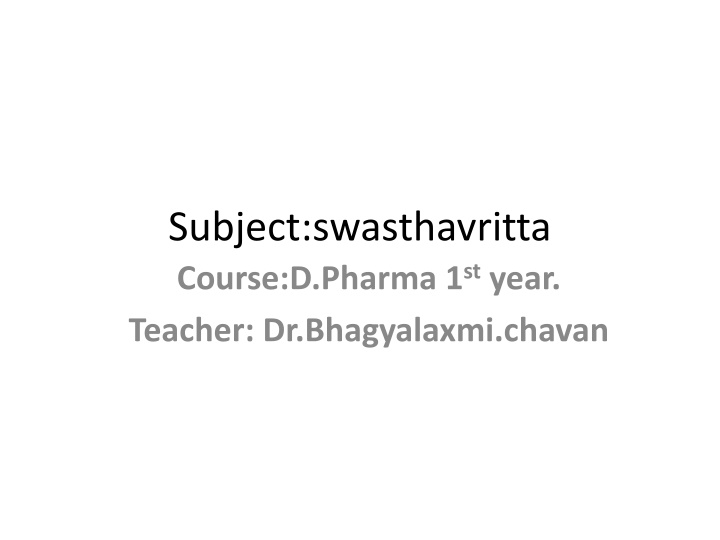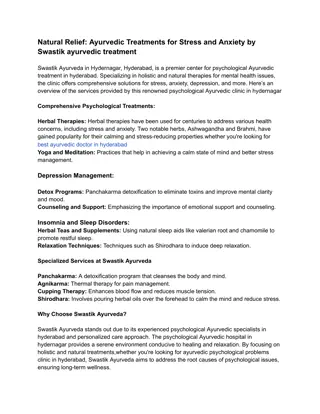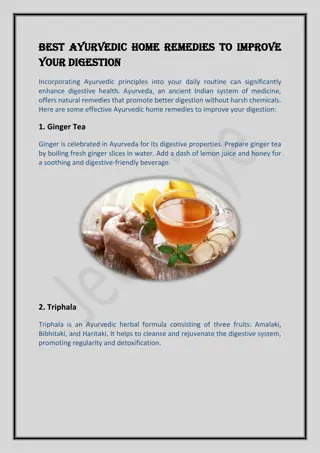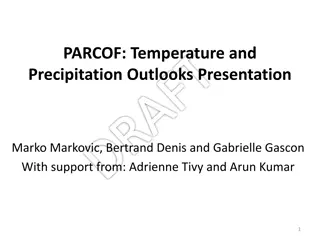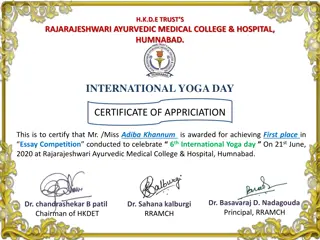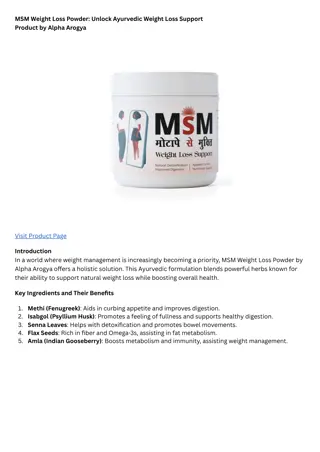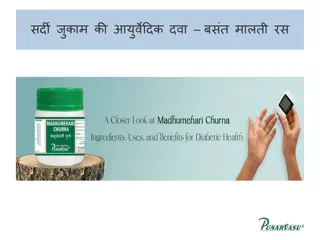Ayurvedic Principles for Seasonal Health Maintenance
Learn about the importance of Ritucharya in Ayurveda, which emphasizes adapting diet and lifestyle according to seasonal changes to maintain optimum health. Discover the effects of Uttarayana and Dakshinayana on the body and environment, providing insights on preventive medicine and seasonal regimens. Explore the significance of Ritus and their impact on health, offering valuable guidance on staying healthy throughout the year.
Download Presentation

Please find below an Image/Link to download the presentation.
The content on the website is provided AS IS for your information and personal use only. It may not be sold, licensed, or shared on other websites without obtaining consent from the author.If you encounter any issues during the download, it is possible that the publisher has removed the file from their server.
You are allowed to download the files provided on this website for personal or commercial use, subject to the condition that they are used lawfully. All files are the property of their respective owners.
The content on the website is provided AS IS for your information and personal use only. It may not be sold, licensed, or shared on other websites without obtaining consent from the author.
E N D
Presentation Transcript
Subject:swasthavritta Course:D.Pharma 1styear. Teacher: Dr.Bhagyalaxmi.chavan
Ritucharya Ritucharya: : Ritu, the season, classified by different features expresses different effects on the body as well as the environment. Ayurveda has depicted various rules and regimens (Charya), regarding diet and behavior to acclimatize seasonal enforcement easily without altering body homeostasis. The prime principle of Ayurvedic system of medicine is preventive aspect, can be achieved by the change in diet and practices in response to change in climatic condition. This is a very important aspect of preventive medicine as mentioned in Ayurvedic texts. Lifestyle disorders are very common in the present era, basically originating from lack of following seasonal regimens due to lack of concentration in seasonal characteristics.
INTRODUCTION The year according to Ayurveda is divided into two periods Ayana (solstice) depending on the direction of movement of sun that is Uttarayana (northern solstice) and Dakshinayana (southern solstice). Each is formed of three Ritus (seasons). The word Ritu means to go. It is the form in which the nature expresses itself in a sequence in particular and specific in present forms in short, the seasons.[6] A year consists of six seasons, namely, Shishira (winter), Vasanta (spring), and Grishma (summer) inUttarayan and Varsha (monsoon), Sharata (autumn), and Hemanta (late autumn) in Dakshinayana. As Ayurveda has its origin in India, the above seasonal changes are observed predominantly in Indian subcontinent.
Uttarayana and its effects; iUttarayana indicates the ascent of the sun or northward movement of the sun. In this period the sun and the wind are powerful. The sun takes away the strength of the people and the cooling quality of the earth. It brings increase in the Tikta (bitter), Kashaya (astringent), and Katu (pungent) Rasa (taste), respectively, which brings about dryness in the body and reduces the Bala (strength). It is also called Adana Kala. According to modern science, this can be compared with the gradual movement of earth around the sun to the position, in which the rays of the sun falls perpendicularly at 30 degree meridian of the North Pole on June 21stevery year, called as summer solstice. The northward journey of the Sun from Tropic of Capricorn to Tropic of Cancer happens. During Uttarayana the seasonal changes in Indian subcontinent is from Shishira (winter) to Vasanta(spring) and to Grishma (summer). The period can be compared to mid- January to mid-July, when warmness and dryness in weather increases. It has an overall debilitating effect on environment, to which human being is also a part.
Dakshinayana and its effect Dakshinayana indicates the descent of the sun or movement of the sun in southern direction. In this period, the wind is not very dry; the moon is more powerful than sun. The earth becomes cool due to the clouds, rain, and cold winds. Unctuousness sets in the atmosphere and Amla (sour), Lavana (salty), and Madhura(sweet) Rasa are predominant, so the strength of person enhances during this period. It is also calledVisarga Kala. According to modern science, this can be compared with the gradual movement of the earth around the sun to the position, in which the rays of the sun fall over 30 degree meridian of the South Pole perpendicularly on December 21stevery year, is called as winter solstice. The southward movement of the Sun occurs from Tropic of Cancer to Tropic of Capricorn. During Dakshinayana, the seasonal changes occur in the Indian subcontinent from Varsha (monsoon) toSarata (autumn) and to Hemanta (late autumn). This period can be compared to mid-July to mid-January, when cool sets, and due to which anabolic activity dominates over the catabolic activity in the environment.
Shishira Shishira (winter) General condition Mid-January to mid-March (approximately) is considered as Shishira Ritu (winter). During this season, the environment remains cold, along with cold wind. The predominant Rasa andMahabhuta during this season are Tikta (bitter) and Akasha, respectively. The strength of the person becomes less, deposition of the Kapha Dosha occurs and Agni (catabolism) remains in a higher state. Diet regimen Foods having Amla (sour) as the predominant taste are preferred. Cereals and pulses, wheat/gram flour products, new rice, corn, and others, are advised. Ginger, garlic, Haritaki (fruits ofTerminalia chebula), Pippali (fruits of Piper longum), sugarcane products, and milk and milk products are to be included in the diet. Foods having Katu (pungent), Tikta (bitter), Kashaya (astringent) predominant Rasa are to be avoided.Laghu (light) and Shita (cold) foods are advised to be prohibited. Lifestyle Massage with oil/powder/paste, bathing with lukewarm water, exposure to sunlight, wearing warm clothes are mentioned to follow. Vata aggravating lifestyle like exposure to cold wind, excessive walking, sleep at late night, are to be avoided. (winter)
Vasanta Vasanta (spring) General condition The approximate time is from mid-March to mid-May. This season is considered as season of flowering and origin of new leaves. Predominant Rasa and Mahabhuta during this season areKashaya (astringent), and Prithvi and Vayu, respectively. Strength of the person remains in medium degree, vitiation of Kapha Dosha occurs and Agni remains in Manda state. Diet regimen One should take easily digestible foods. Among cereals, old barley, wheat, rice, and others are preferred. Among pulses, lentil, Mugda, and others, can be taken. Food items tasting Tikta (bitter), Katu(pungent), and Kashaya (astringent) are to be taken. Besides those, honey is to be included in the diet. Meats like that of Shahsa (rabbit), which are easy to digest can be taken. Foods which are hard to digest are to be avoided. Those which are Sheeta (cold), Snigdha (viscous), Guru(heavy), Amla (sour), Madhura (sweet) are not preferred. New grains, curd, cold drinks, and so on, are also to be prohibited. Lifestyle One should use warm water for bathing purpose, may do exercise during Vasant Ritu. Udvartana(massage) with powder of Chandana (Santalum album), Kesara (Crocus sativus), Agaru, and others,Kavala (gargle), Dhooma (smoking), Anjana (collyrium), and evacuative measures, such as Vamana andNasya are advised. Day-sleep is strictly contraindicated during this season. (spring)
Grishma (summer) General condition Mid-May to mid-July (approximately) is considered as Grishma (summer) season. Environment is prevalent with intense heat and unhealthy wind. The river-bodies dried and the plants appear lifeless. The predominant Rasa is Katu (pungent) and Mahabhuta are Agni and Vayu. The strength of the person become less, deposition of Vata Dosha occurs, but the vitiated Kapha Dosha is pacified during this season. Agni of the person will remain in mild state. Diet regimen Foods which are light to digest those having Madhura (sweet), Snigdha (unctuous), Sheeta(cold), and Drava (liquid) Guna, such as rice, lentil, etc, are to be taken. Drinking plenty of water and other liquids, such as cold water, buttermilk, fruit juices, meat soups, mango juice, churned curd with pepper, is to be practiced. At bedtime milk with sugar candy is to be taken. Lavana and food with Katu (pungent) and Amla (sour) taste and Ushna (warm) foods are to be avoided. Lifestyle Staying in cool places, applying sandal wood and other aromatic pastes over the body, adorning with flowers, wearing light dresses and sleeping at day time are helpful. During night one can enjoy the cooled moonrays with breeze. Excessive exercise or hardwork is to be avoided; too much sexual indulgence and alcoholic preparations are prohibited.
Varsha (monsoon) General condition Mid-July to mid-September (approximately) is considered as Varsha Ritu. During this season the sky is covered by clouds and rains occur without thunderstorm. The ponds, rivers, etc., are filled with water. The predominant Rasa and Mahabhuta during this season are Amla (sour), and Prithvi andAgni, respectively. The strength of the person again becomes less, vitiation of Vata Dosha and deposition of Pitta Dosha, Agni also gets vitiated. Diet regimen Foods having Amla (sour) and Lavana (salty) taste and of Sneha (unctuous) qualities are to be taken. Among cereals, old barley, rice, wheat, etc., are advised. Besides meat soup, Yusha (soup), etc. are to be included in the diet. It is mentioned that one should take medicated water or boiled water. Intake of river water, churned preparations having more water, excessive liquid and wine are to be avoided. The foods, which are heavy and hard to digest, like meat, etc., are prohibited. Lifestyle Use of boiled water for bath and rubbing the body with oil properly after bath is advised. Medicated Basti (enema) is prescribed as an evacuative measure to expel vitiated Doshas. Getting wet in rain, day-sleep, exercise, hard work, sexual indulgence, wind, staying at river- bank, etc., are to be prohibited.
Sharat (autumn) General condition The period between mid-September to mid-November is Sharat Ritu (autumn). During this time the Sun becomes bright, the sky remains clear and sometimes with white cloud, and the earth is covered with wet mud. The predominant Rasa is Lavana (salty) and predominant Mahabhutas are Apa andAgni. The strength of the person remains medium, pacification of vitiated Vata Dosha and vitiation of Pitta Dosha occur, and activity of Agni increases during this season. Diet regimen Foods are having Madhura (sweet) and Tikta (bitter) taste, and of Laghu (light to digest) and cold properties are advised. Foods having the properties to pacify vitiated Pitta are advised. Wheat, green gram, sugar candy, honey, Patola (Trichosanthes diocia), flesh of animals of dry land (Jangala Mamsa) are to be included in the diet. Hot, bitter, sweet, and astringent foods are to be avoided. The food items, such as fat, oils, meat of aquatic animals, curds, etc., are also to be not included in the diet during this season. Lifestyle Habit of eating food, only when there is a feeling of hunger is recommended. One should take water purified by the rays of sun in day time and rays of moon at night time for drinking, bathing, etc. It is advised to wear flower garlands, and to apply paste of Chandana (Santalum album) on the body. It is said that moon rays in the first 3 h of night is conducive for health. Medical procedures, such as Virechana(purging), Rakta-Mokshana (blood letting), etc, should be done during this season. Day-sleep, excessive eating, excessive exposure to sunlight, etc., are to be avoided.
Hemanta Hemanta (late autumn) (late autumn) General condition Mid-November to mid-January is considered as Hemanta (late autumn) Ritu. Blow of cold winds starts and chillness is felt. Predominant Rasa during this season is Madhura and the predominant Mahabhutas are Prithivi and Apa. The strength of a person remains on highest grade and vitiated Pitta Dosha gets pacified. Activity of Agni is increased. Diet regimen One should use unctuous, sweet, sour, and salty foods. Among cereals and pulses, new rice, flour preparations, green gram, Masha, etc., are mentioned to be used. Various meats, fats, milk and milk products, sugarcane products, Shidhu (fermented preparations), Tila (sesame), and so on, are also to be included in the diet. Vata aggravating foods, such as Laghu (light), cold, and dry foods are to be avoided. Intake of colddrinks is also contraindicated. Lifestyle Exercise, body and head massage, use of warm water, Atapa-sevana (sunbath), application ofAgaru on body, heavy clothing, sexual indulgence with one partner, residing in warm places is recommended. Exposure to strong and cold wind, habit of day sleep, etc., are mentioned to be avoided.
